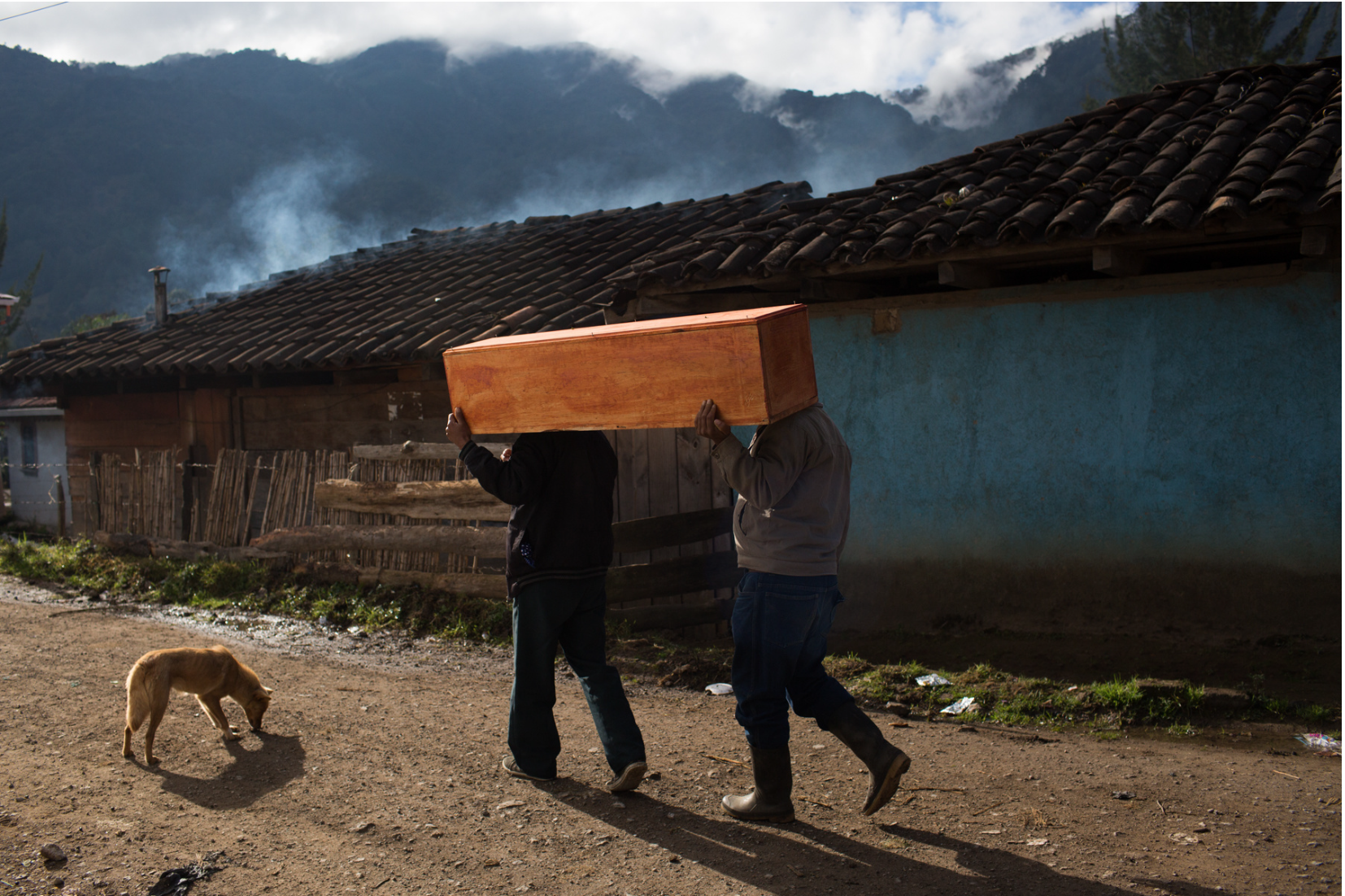James Rodríguez’s photo series Guatemala, Life After Genocide explores the aftermath of the Guatemalan civil war that occurred between 1960 and 1996—a conflict that negatively influenced the lives of over 250,000 civilians. In this photograph, two Guatemalan men are shown carrying a wooden casket containing the remains of their relative Jacinta Solis de Leon along a dirt road. These family members are positioned in the image’s center, their faces concealed by the casket that is laying on top of their shoulders. To the left of the men is a malnourished dog with visible rib structures, who is depicted investigating the dirt road, presumably looking for food or water. Behind these forms is a row of single-story houses that spans the composition’s width, all of which have tiled ceilings comprised of dark brown tiles and a strip of grass full of litter that separate the properties from the dirt path. However, it is through the use of composition, lighting, and framing that Rodríguez is able to imbue his photograph with a strong sense of visual cohesion and somberness. For instance, the horizontal lines that can be found in the positioning of objects like the dirt path, grassy strip, house ceilings, and casket guide the viewer’s eye from right to left, providing an implied feeling of movement that reinforces the journey that the two Guatemalan are presently making with their casket. Furthermore, the wooden casket’s bright, almost glowing orange hue contrasts nicely with the more muted blue and brown colors that occupy the image’s background, as seen in the houses’ wall textures. A similar example of this type of color balance can be observed in the warm and brighter brown tones of the dog’s fur, dirt path, and wooden house structure complementing the cooler and more dull blues of the atmosphere and walls that occupy the image’s topmost region. These choices in color result in an image that looks visually bleak, a fitting choice since the photo is meant to document the movement of a dead person’s remains. Rodríguez’s use of lighting furthers this idea, as his figures are all cloaked in shadow, reinforcing that the brighter casket—and, by proxy, the human remains inside it—are the photograph’s true focus. Additionally, the image’s close framing implies that the viewer is personally witnessing the casket’s progression, as if they were another member of the grieving family—another method Rodríguez uses to convey the deeply sad nature of his image. Despite these visual choices, Rodríguez also allows his image to contain a sense of optimism and unity as a result of his composition and lighting choices. For example, the sun’s lighting outside of the image’s leftmost view is still noticeable due to the outlines it leaves on the left sides of both the two men and the stray dog. When paired with the movement of the casket and men going from right to left, which is reinforced by the sloping lines present in the background, this effect creates a visual metaphor for the closure countless Guatemalans might be having as a result of finally being able to bury their loved ones after decades of uncertainty and despair. Similarly, the placement of the casket in lieu of the men’s faces gives the two figures an anonymity that can allude to how approximately 250,000 civilians were dealing with the similar experience of burying a corpse recently identified as family. Consequently, this framing allows Rodríguez to not only pay homage to the grief countless Guatemalans were feeling as a result of the war, but also reflect the healing process the people of Guatemala will undergo in the future, in addition to the hope they have of collectively heading towards brighter days in which they receive justice for the actions of their corrupt government.
mountainside in 1982 fleeing from State-led repression. Acul, Nebaj, Quiche, Guatemala, 2017″
Guatemala, Life After Genocide, James Rodríguez, 2017.
Located on Mimundo
Photo Citation:
Rodríguez, James. “Guatemala, Life After Genocide.” Mimundo, 2017, http://www.mimundo.org/2332522-guatemala-life-after-genocide#0. Accessed 5 September 2021.



Well written, thorough and sensitive response to the prompt. Good observation of warm and cool hues and directional lines.